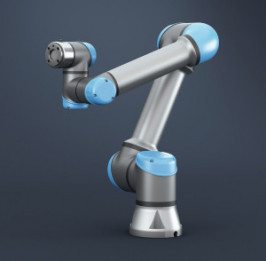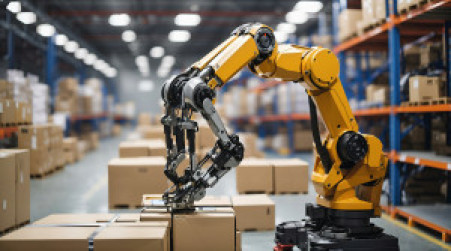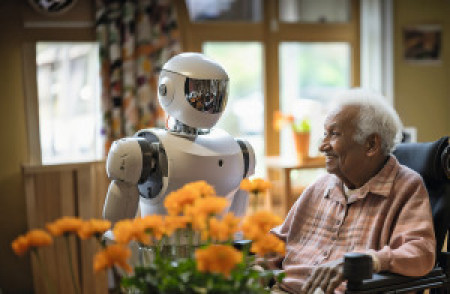Collaborative robots have no passive safety devices. They work freely without a cage at their assigned position. This has the advantage that they are very flexible and therefore particularly interesting for small electroplating companies. The disadvantage is that they pose a risk of accidents.
Collaborative robots are colloquially known as cobots. The abbreviation comes, like so many things, from the Anglo-American language area and is a combination of parts of the English term collaborate robots. A cobot is characterized by the fact that it works closely with its human colleagues and is not separated from them by a protective device. This has undeniable advantages. The cobot is extremely flexible. As it generally weighs less (and therefore does not need to be permanently installed) than its industrial counterpart, it can be easily repositioned and reprogrammed to perform different tasks within a company. As if that were not enough, the cobot is capable of real collaboration, working hand-in-hand with humans, so to speak. However, the lack of an enclosure also makes it a real source of danger in the production process in terms of occupational safety. While a cobot can relieve a human employee of heavy work, it can also injure them in the event of a collision. Collaborate robots are so-called "partly completed machinery" and therefore do not receive a CE certificate
Collaborate robots are so-called "partly completed machinery" and therefore do not receive a CE certificate
Tolerable level of injury?
The Institute for Occupational Safety and Health (IFA) and the German Social Accident Insurance (DGUV), however, consider the risk of accidents in connection with cobots to be negligible and speak of a "tolerable risk of injury". However, the following must be said: There are still no broad-based, meaningful accident statistics in occupational safety, let alone a study dedicated exclusively to the topic of cobots. In the overall field of robotics, i.e. industrial robots, pick-and-place machines, production lines and cobots as a whole, more than 2000 accidents were recorded in four years. Of these, pure industrial robotics (i.e. including cobots) accounted for 771 accidents. Only three of these were fatal. As far as only cobots are concerned, there are only three known cases that occurred during the installation phase, i.e. when setting up the lightweight robots. None of these three cases ended fatally, but "only" with serious injuries.
However, Einstein already knew that everything is relative in life in general and in physics in particular. So it is a fact that cobots are still quite rare in Central European companies - which results in a comparatively low risk of accidents. Another fact in this context is the machines' areas of work. So far, they have been used for less complex tasks. For example, in the grinding of simple surfaces, in positioning, as screwdrivers or in shipping as packers. Cobots are also already providing good service in gluing work. These are all tasks with a low risk potential. Furthermore, the hand-in-hand work of man and machine mentioned at the beginning of this article is still a dream of the future in many areas. In fact, the two very different colleagues work far less closely together than the name of the machine suggests. Experts therefore prefer to speak of coexistence or assistance rather than collaboration. In current practice in Central European companies, humans and cobots are so far apart in terms of both space and time that accidents are unlikely to occur. What does that mean? An unprotected robot carries out its work so far away from the employee that there is no danger to the employee. Only when the robot has completed its work and has come to rest (time factor) does the human access the workpieces. Even if the robot is no longer protected by a basket or a barrier, it still has a wide range of safety technologies. For example, a proximity sensor signals a critical distance from the human. Touch sensors, cameras and heat detection stop the machine immediately if danger levels are reached.
Design and safety
As already mentioned, cobots are not industrial robots. Their design alone is such that cooperation with humans cannot lead to any significant injuries, even in the event of violent contact between man and machine:
- The working speed of these robots is matched to that of humans
- The cobots have no corners or edges and, where possible, are made of soft materials
- The maximum reach of the arms is 60 centimeters
- The weight of the cobots is reduced to a maximum of 30 kilograms
Nevertheless, employers would do well to introduce additional safety measures. This is partly (and most importantly) due to their duty of care towards their employees, as well as to insurance companies. And, of course, every accident also means a production stoppage and therefore a loss of work. The following safety measures have proven their worth:
Access restriction
The working radius of the robot must be clearly marked. Only authorized persons, ideally those who work with the robot, are allowed within the marked area. The number of persons should be kept as low as possible.
Information signs
Clearly recognizable warning signs must be displayed in the vicinity of the cobot. These should draw attention to the dangers and give instructions on how to behave (keep a safe distance; do not touch, etc.) - preferably using comprehensible pictograms.
Emergency stop
Emergency stop switches must be installed in the vicinity of the cobot. These switches (preferably several of them) must be operable without entering the danger zone of the machine. Two options are available. One is a switch that freezes the movement and the other is a switch that switches the machine off completely. Even strangers must be able to recognize, reach and operate these switches. It should be possible to reach and operate it with both arms and legs.
Employees
The employees who will later work directly and indirectly with the machine must already be involved in the planning phase. Ideas and suggestions should be taken into account where feasible.
Qualification
All employees working in the vicinity of the cobot, including in particular the stand-in operators, must receive safety training. Refresher courses at regular intervals are mandatory.
The role of the manufacturer
A manufacturer usually only guarantees the technical function and safety of the robot. However, they do not guarantee what we call the complete package of the system. This does not only consist of the machine itself. A tool applied to the robot arm (drill, screwdriver, glue, etc.) is usually purchased from another manufacturer and forms a unit together with the robot and, above all, the workpiece. From a legal point of view, a cobot is therefore partly completed machinery. It therefore does not receive a CE marking but only a declaration of incorporation. The user is therefore only on the safe side if the robot, the tool and the application environment are combined to form a chain and this has been evaluated in accordance with the Machinery Directive 2006/42/EC and the risk assessment in accordance with the Occupational Health and Safety Act.




